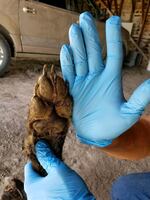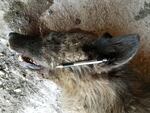
Doubts arose about what the animal was since the front paw appeared too short and the front claws too long to be a purebred wolf.
Montana Fish, Wildlife and Parks via AP
In mid-May, a rancher shot and killed a wolf-like animal on a ranch outside of Denton, Montana. The rancher reported the shooting, which is required by law, to the Montana Fish, Wildlife and Parks department.
But after wolf specialists saw photos of the animal, they raised doubts about whether it was actually a purebred wolf.
A press release from the Montana FWP said the doubt was spurred by a few factors: the "canine teeth were too short, the front paws too small and the claws on the front paw were too long."
This is where Ken Goddard came in.
Goddard is the laboratory director at the U.S. Fish & Wildlife Service National Forensics Laboratory in Ashland, Oregon. He talked to OPB "All Things Considered" host Kate Davidson this week about the lab and this particular mystery animal.
The Ashland facility describes itself as the only crime lab in the world focused on wildlife law enforcement. Since its inception 30 years ago, it has functioned in a lot of the same ways a typical police crime lab does, such as examining evidence and trying to link suspects to crime scenes.
“The only difference between a wildlife crime lab like ours and other [forensic] labs is we first have to figure out what our victim is,” Goddard said. “It makes huge difference whether it’s endangered, threatened, protected or if there’s nothing wrong with killing it in the first place.”

It's also thought the canine teeth are too short and ears too tall in proportion to the skull.
Montana Fish, Wildlife and Parks via AP
A tissue sample of the Montana animal was sent to the lab, which will use its DNA library, including more than 40,000 tissue samples, to help identify what it is. It's possible the wolf-like creature is a hybrid of, say, a wolf and a dog. And if it is, the dog itself could be a mix of multiple breeds.
“We may not be able to tell the exact hybrid mix," Goddard said, "but we should be able to describe that it’s not for example an extinct wolf, or a werewolf, or any of the other interesting possibilities.”
But Goddard wouldn't make any predictions before the lab finished its work.
“We don’t know [what it is] yet," he said. "We will find out with our DNA test and because it’s an investigation, we won’t be able to talk about it until the investigation is closed.”
To hear the entire conversation with Ken Goddard, use the audio player at the top of this story.